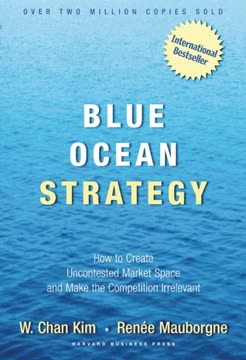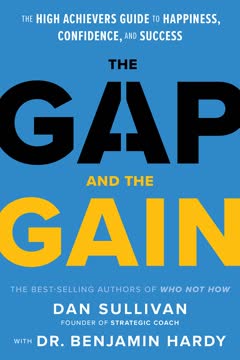Key Takeaways
1. Meaning: Ground Your Brand in Purpose and Significance
To build a standout brand, you must be grounded in meaning.
Beyond Differentiation. In today's crowded marketplace, simply differentiating your brand isn't enough. You need to create meaning, imbuing your brand with purpose and significance that resonates with your audience. This involves understanding what your customers truly care about and aligning your brand with their values and aspirations.
Start with Your People. Meaning comes from your audience. Understand their needs, desires, and motivations. Go beyond demographics and create rich customer profiles that capture their psychographics and emotional drivers. Lululemon's "Ocean" and "Duke" personas are examples of aspirational customer archetypes that speak to the meaning customers seek in their lives.
Head and Heart. Connect with customers on both intellectual and emotional levels. Appeal to their heads by offering practical benefits like convenience, safety, and simplicity. Appeal to their hearts by evoking emotions like belonging, nostalgia, and humor. By creating meaning in both the head and the heart, you can build a brand that is both valued and loved.
2. Structure: Re-Sequence Your Brand DNA for a Digital World
Like the individual pieces of DNA that contain genetic information, each of these pieces says something about your brand but isn’t the full story—to say nothing of the fact that you no longer know in what order your consumers are encountering your various touchpoints.
Beyond Traditional Building. Brand-building is no longer a linear process. Instead of thinking of your brand as a structure with a foundation and levels, consider it as a collection of DNA fragments. These fragments represent your brand's touchpoints, such as your logo, slogan, products, advertising, and customer service.
Dimmer Switch Approach. Think of your brand's structure as a light switch with dimmers for every possible touchpoint. You can turn some up, some down, and others partially up or down. This allows you to prioritize the touchpoints that are most relevant to your brand promise and customer needs. Zappos, for example, turns down TV ads but turns up customer service emails.
Creating Brand Patterns. In a chaotic media landscape, patterns help consumers make sense of your brand. Create consistent and flexible patterns in your visuals, content, and interactions. Google's use of four primary colors across its products is a subtle yet powerful pattern that reinforces its brand.
3. Story: Craft a Compelling Narrative with Archetypes and Voice
Story is about trying to make sense out of the confusion, chaos, and terror of being a human being.
Hardwired for Story. Our brains are hardwired for comprehending stories. Stories activate multiple areas of the brain, create neural coupling between the listener and speaker, and release dopamine, making them easily remembered and shared. This makes storytelling a powerful tool for brand-building.
Story Archetypes. Use familiar story archetypes to connect with your audience on a deeper level. Christopher Booker's seven basic plots, such as "Overcoming the Monster," "Rags to Riches," and "The Quest," provide a framework for crafting compelling brand narratives. Apple, for example, has always fought the monster.
Characters, Conflict, and Voice. Your brand story should feature compelling characters, a central conflict, and a distinctive voice. Make your customer the hero of the story, identify the challenges they face, and tell the story in a way that is authentic to your brand's personality. Duluth Trading Company's blunt, descriptive language is a perfect fit for their target audience of tradespeople.
4. Content: Share Your Brand's Story Through Customer-Centric Value
To break this down, we’ll explore what makes good content, how the layers of your story become levels of your content, and we’ll examine the question on every marketer’s mind—how much content is enough?
Beyond "Content is King." In today's content-saturated world, simply producing more content isn't enough. You need to create better content that is both business-centric and customer-aware. This means grounding your content in your brand's story and delivering value to your audience.
Customer-First Content. Focus on answering your customers' questions and solving their problems. Marcus Sheridan's "They Ask, You Answer" philosophy emphasizes the importance of addressing customer concerns directly through your content. Dollar Shave Club's blog answers men's questions about grooming and health, building trust and engagement.
Content Brands. Create content brands that people want to hear from. Instead of creating branded content that promotes your products, create content brands that provide value and build relationships with your audience. Blendtec's "Will It Blend?" series is a content brand that entertains and showcases the power of their blenders.
5. Community: Cultivate Advocates by Working Your Circles
You have to prioritize.
Beyond Marketing to the Masses. In today's interconnected world, building a brand is about cultivating a community of advocates. This involves prioritizing your relationships and focusing on the people who are already invested in your brand.
Concentric Circles. Think of your brand's community as a series of concentric circles, with your employees at the center, followed by partners, loyal customers, transactional customers, and prospects. Prioritize your efforts by focusing on the inner circles first. Zappos' culture book and Coldwell Banker's brand storybook are examples of how to engage employees.
Brand Gravity. Create brand gravity that pulls your community in. This involves using your story and content to attract and engage your audience, inspiring them to become advocates for your brand. Flow Hive's content inspires customers to become beekeepers and share their experiences.
6. Clarity: Embrace Transparency and Simplicity to Cut Through the Noise
Today, if you lie, you die.
Transparency is Key. In an age of instant information and social media scrutiny, transparency is essential for building trust. Be open and honest about your business practices, values, and mistakes. Patagonia's commitment to sustainability and Chobani's response to a product recall are examples of transparency in action.
Simplicity Matters. In a cluttered marketplace, simplicity is a powerful differentiator. Simplify your messaging, your products, and your customer experience. IKEA's minimalist design and straightforward assembly instructions are a testament to the power of simplicity.
Subtract to Amplify. Sometimes, the best way to stand out is to subtract. By removing unnecessary features, messages, and touchpoints, you can amplify your brand's core meaning and make it easier for customers to understand what you stand for. Google's minimalist search page is a prime example.
7. Experience: Deliver Your Brand Promise Consistently and Coherently
Branding is thousands of tiny punches that add up.
Beyond Consistency. Brand experience is more than just consistency; it's about coherence. This means ensuring that all your touchpoints, from your website to your customer service interactions, are aligned with your brand's meaning and story.
Touchpoint Mapping. Map out your brand's touchpoints to identify opportunities for improvement. Consider the customer's journey and ensure that each interaction is seamless and engaging. The SPAM Museum is an example of an immersive brand experience that brings the brand to life.
Culture is Key. A strong organizational culture is essential for delivering a great brand experience. Empower your employees to be brand ambassadors and create a culture that values customer satisfaction. Zappos's culture book and Maker's Mark's brand presentation are examples of how to cultivate a strong brand culture.
8. Humor: Inject Personality and Connection with Strategic Levity
Humor can help you stand out in a crowded world.
Cut Through the Clutter. Humor is a powerful tool for cutting through the clutter and capturing attention. A well-placed joke can make your brand more memorable and likable. Dollar Shave Club's humorous video is a prime example.
Authenticity is Key. Humor must be authentic to your brand's personality. Don't force it if it doesn't feel natural. BarkBox's playful content and Charmin's potty humor are examples of brands that use humor effectively.
Surround Yourself with Funny People. If humor doesn't come naturally to you, surround yourself with people who are funny. Hire comedians, consult with improv groups, and create a culture that encourages levity. Cisco's hiring of Tim Washer is an example of this.
9. B2B Branding: Leverage Expertise and Relationships in a Complex World
So . . . what ? Well, we have a very complicated product and we’re in a very conservative industry.
Embrace Complexity. B2B brands often face the challenge of communicating complex products and services to a sophisticated audience. Embrace this complexity by showcasing your expertise and providing valuable insights. IBM Watson Group's blog is an example of content that demonstrates expertise.
Focus on Relationships. B2B branding is about building long-term relationships with your customers. Focus on providing exceptional customer service and building trust.
Leverage Content and Community. Use content to guide customers through the complex sales cycle and build a community of engaged users. Lucky Pawz's blog provides peace of mind to pet parents.
10. Small Business Branding: Nimble, Authentic, and Community-Focused
Scratch was born from a love of making people smile.
Authenticity Matters. Small businesses have the advantage of being authentic and personal. Embrace this by sharing your story and connecting with your customers on a human level. Scratch Cupcakery's story is rooted in a love of baking and making people smile.
Community is Key. Small businesses are often deeply rooted in their communities. Leverage this by building relationships with local customers and supporting local causes. RAYGUN's focus on Midwestern cities is an example of community-focused branding.
Experience is Everything. Create a memorable brand experience that reflects your values and personality. Hills Bank and Trust Company's History Room is an example of a unique and engaging brand experience.
11. Personal Branding: Define Your Value and Share Your Authentic Self
It’s important to build a personal brand because it’s the only thing you’re going to have.
Define Your Value. What do you want to be known for? What are your unique skills and talents? Define your personal brand spark and use it as a guide for everything you do.
Tell Your Story. Share your story in a way that is authentic to your personality. Use story archetypes to connect with your audience on a deeper level.
Build a Community. Connect with your audience on social media and in person. Share your insights, engage in conversations, and build relationships.
12. Political Branding: Connect with Voters Through Story and Clarity
We can’t do any of that.
Meaning and Purpose. Political brands need to connect with voters on a deeper level by articulating a clear vision for the future. This involves understanding the needs and aspirations of the community and offering solutions that resonate with their values.
Story and Authenticity. Voters are drawn to candidates who have compelling personal stories and who are authentic in their beliefs. Sharing personal experiences and connecting with voters on an emotional level can build trust and rapport.
Clarity and Simplicity. In a crowded political landscape, it's essential to communicate your message with clarity and simplicity. Focus on a few key issues and articulate your positions in a way that is easy for voters to understand.
Last updated:
Review Summary
Brand Now receives mostly positive reviews, with an average rating of 4.03 out of 5. Readers appreciate its practical advice, engaging writing style, and helpful examples. Many find it useful for marketers and business owners, praising its clarity and actionable insights. Some critics note that the content can be introductory or superficial, lacking groundbreaking ideas. Overall, the book is commended for its approachable take on branding, though a few readers found it dry or difficult to follow without marketing background.
Similar Books





Download PDF
Download EPUB
.epub digital book format is ideal for reading ebooks on phones, tablets, and e-readers.




